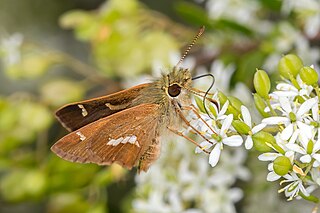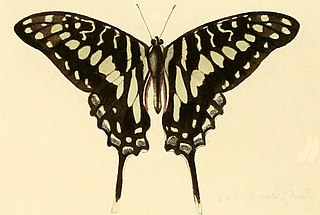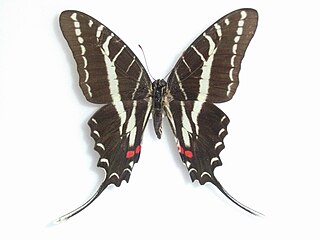
Papilio glaucus, the eastern tiger swallowtail, is a species of butterfly native to eastern North America. It is one of the most familiar butterflies in the eastern United States, ranging north to southern Ontario, Canada, and is common in many different habitats. It flies from spring until fall, during which it produces two to three broods. Adults feed on the nectar of many species of flowers, mostly from those of the families Apocynaceae, Asteraceae, and Fabaceae. P. glaucus has a wingspan measuring 7.9 to 14 cm. The male is yellow with four black "tiger stripes" on each forewing. Females may be either yellow or black, making them dimorphic. The yellow morph is similar to the male, but with a conspicuous band of blue spots along the hindwing, while the dark morph is almost completely black.

Eurytides marcellus, the zebra swallowtail, is a swallowtail butterfly native to the eastern United States and south-eastern Canada. It is the state butterfly of Tennessee. Its distinctive wing shape and long tails make it easy to identify, and its black-and-white-striped pattern is reminiscent of a zebra. The butterflies are closely associated with pawpaws, and are rarely found far from these trees. The green or black caterpillars feed on the leaves of various pawpaw species, while the adults feed on flower nectar and minerals from damp soil.

Acraea terpsicore, the tawny coster, is a small, 53–64 millimetres (2.1–2.5 in), leathery-winged butterfly common in grassland and scrub habitats. It belongs to the Nymphalidae or brush-footed butterfly family. It has a weak fluttery flight. It is avoided by most insect predators. This species and the yellow coster are the only two Indian representatives of the predominantly African tribe Acraeini. It is found in India, Sri Lanka, Indonesia, Maldives to Myanmar, Thailand, Laos, Cambodia, Vietnam, Bangladesh, Malaysia, Singapore, and recently Australia.

Papilio demoleus is a common and widespread swallowtail butterfly. The butterfly is also known as the lime butterfly, lemon butterfly, lime swallowtail, and chequered swallowtail. These common names refer to their host plants, which are usually citrus species such as the cultivated lime. Unlike most swallowtail butterflies, it does not have a prominent tail. When the adult stage is taken into consideration, the lime swallowtail is the shortest-lived butterfly, with male adults dying after four days and females after a week. The butterfly is native to Asia and Australia, and can be considered an invasive pest in other parts of the world. The butterfly has spread to Hispaniola island in the Western Hemisphere, and to Mahé, Seychelles.

Graphium agamemnon, the tailed jay, is a predominantly green and black tropical butterfly that belongs to the swallowtail family. The butterfly is also called the green-spotted triangle, tailed green jay, or green triangle. It is a common, non-threatened species native to Nepal, India, Sri Lanka through Southeast Asia and Australia. Several geographic races are recognized. The species was first described by Carl Linnaeus in his 1758 10th edition of Systema Naturae.

Graphium nomius, the spot swordtail, is a butterfly found in South and Southeast Asia that belongs to the swallowtail family. The species was first described by Eugenius Johann Christoph Esper in 1793. One of the grandest sights is a host of spot swordtails mud-puddling or swarming around a flowering forest tree.

Graphium eurypylus, the great jay or pale green triangle, is a species of tropical butterfly belonging to the family Papilionidae.

Lampides boeticus, the pea blue, or long-tailed blue, is a small butterfly that belongs to the lycaenids or gossamer-winged family.

Ideopsis vulgaris, the blue glassy tiger, is a butterfly that belongs to the crows and tigers, that is, the danaid group of the brush-footed butterflies family.

Papilio aegeus, the orchard swallowtail butterfly or large citrus butterfly is a species of butterfly from the family Papilionidae, that is found in eastern Australia and Papua New Guinea.

Polyura (pyrrhus) sempronius, the tailed emperor, is a large butterfly by Australian standards, with a wingspan of some 75 mm for males and 85 mm for females. The uncommon but widespread butterfly occurs in a variety of habitat types in northern and eastern Australia, where it occurs predominantly in the warm and subtropical coastal regions. It is a resident species where its food plants, certain legumes and kurrajongs, are native.

Trapezites iacchoides, commonly known as the silver studded ochre or iacchoides skipper, is a species of butterfly in the family Hesperiidae. It is endemic to Australia, where it occurs in New South Wales, Queensland and Victoria. It inhabits cool, temperate, open eucalypt forests.

The silky hairstreak or chlorinda hairstreak is a butterfly belonging to the family Lycaenidae. The species was first described by Emile Blanchard in 1848. It occurs in Australia. It is the only species in the monotypic genus Pseudalmenus, described by Hamilton Herbert Druce in 1902.

Dispar compacta, commonly known as the dispar skipper, barred skipper, or barred grass-skipper, is a species of butterfly in the family Hesperiidae. It was described by Arthur Gardiner Butler in 1882 as Telesto compacta and is endemic to eastern Australia.

Graphium antheus, the large or larger striped swordtail, is a species of butterfly in the family Papilionidae (swallowtails), found in tropical and sub-Saharan Africa.

Graphium porthaon, the coastal swordtail, cream-striped swordtail or dark swordtail, is a species of butterfly in the family Papilionidae, found in tropical western Africa.

Graphium colonna, the black swordtail or mamba swordtail, is a species of butterfly in the family Papilionidae (swallowtails). It is found in Africa.

Eurytides philolaus, the dark zebra swallowtail or dark kite-swallowtail, is a butterfly of the family Papilionidae. It is found from southern Texas to northern South America.

Graphium polistratus, the dancing swordtail, is a butterfly in the family Papilionidae (swallowtails). It is found in Nigeria, the Democratic Republic of the Congo, the coast of Kenya, Tanzania, northern Malawi and Mozambique. Its habitat consists of warm and coastal forests.

Charaxes latona, the orange emperor, is a butterfly of the rajahs and nawabs group, i.e. the Charaxinae group of the brush-footed butterflies family. It is native to the tropical rainforests of eastern Indonesia, western Melanesia and far northern Queensland, Australia, where it is limited to the Iron Range.




















